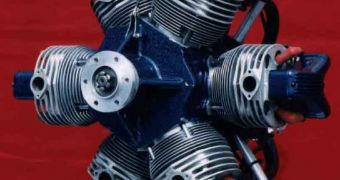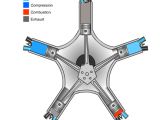Radial engines became widely popular during the World War II and have been mostly used to power the propellers of airplanes such as the B-25 and the B-17 bombers, or even commercial airplanes like the DC-3. Basically, a radial engine is similar to gasoline internal combustion engines, only that the pistons are disposed in a special configuration which gives it an excellent weight to power ration, making it ideal for airplane propulsion.
As you probably already know, gasoline internal combustion engines come in a variety of configurations. They could have a number of pistons, disposed in different arrangements. Motorcycle engines for example, generally have two pistons in a 'V' configuration. The vast majority of cars currently circulating in the world have between three and twelve pistons, again, arranged at an angle describing a 'V' shape.
Some high performance vehicles however, may have the pistons arranged on two collinear banks, in order to reduce the vibration produced by the pistons moving inside the cylinders at high speeds. As you can see, different vehicles use different types of engines suited for their requirements. During the World Way II, the radial engines came to be the perfect solution for airplanes.
Typical radial engines have the pistons arranged in a circle, with the crankshaft rotating between them as shown in the picture bellow. This particular type of engine has five cylinders, albeit the number can vary between three and nine. The basic functioning of this engine design is similar to that of typical internal combustion engines. Gas is compressed inside a cylinder, then it is lit with the help of a spark plug. The fuel expands rapidly as is burns pushing the piston down the cylinder, thus rotating the crankshaft.
The main advantage over the typical internal combustion engine design is that the crankshaft no longer needs to be articulated. A single hub to convert the linear motion to rotational motion can be used, which means that the overall weight of the engine is significantly reduced.

 14 DAY TRIAL //
14 DAY TRIAL // 
